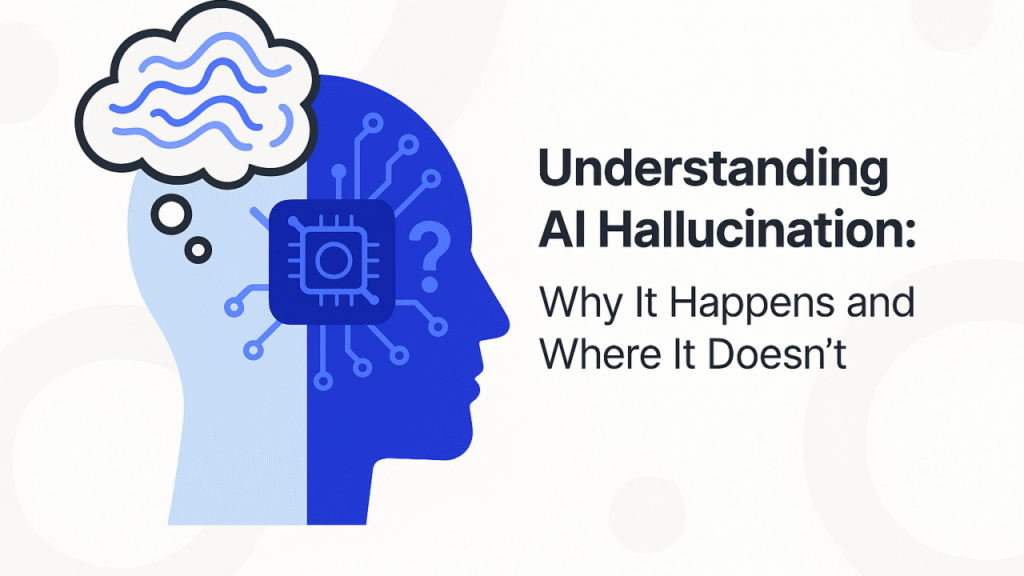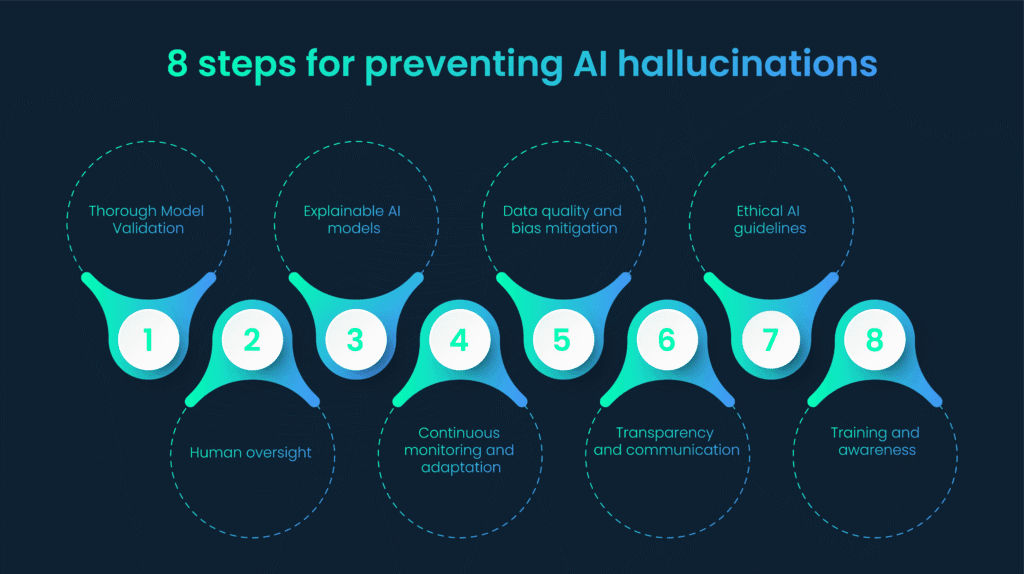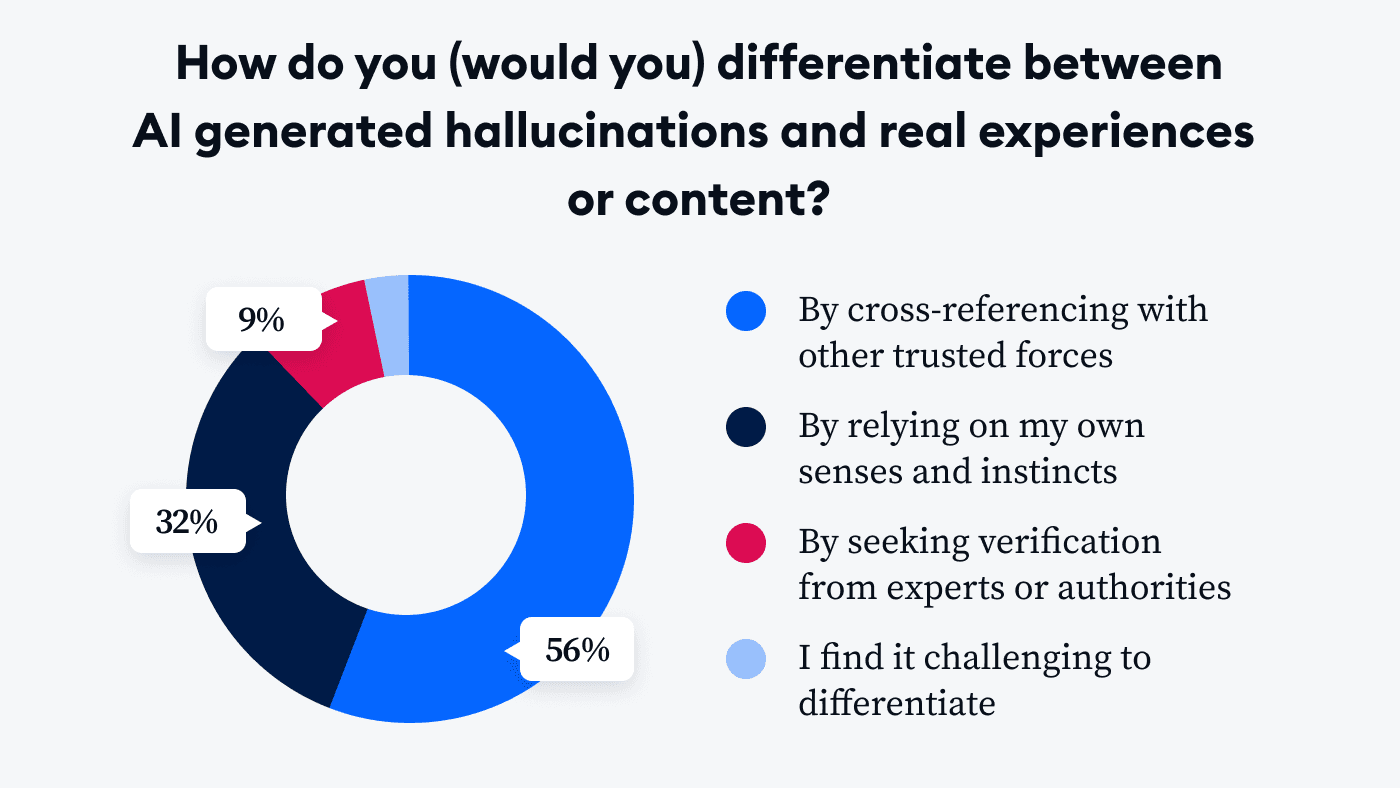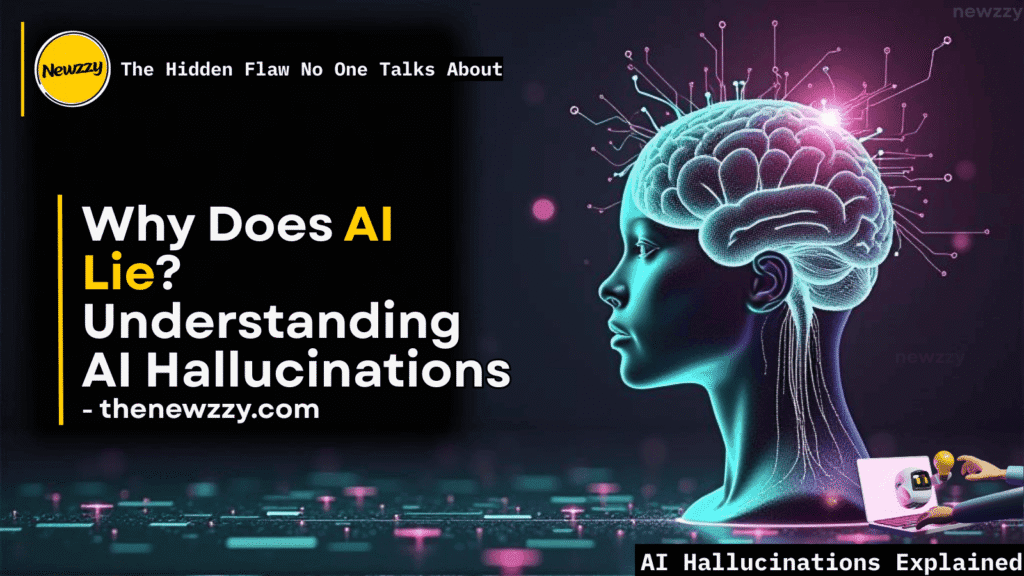AI Hallucination:: The severity of this matter can be best described with a powerful practical case. In 2023, lawyer Steven A. Schwartz filed a legal brief to a district court that cited six totally made up favorable precedents. The hypothetical ones did not exist, but were fictional cases generated by the generative AI, ChatGPT, that the attorney had used to research the case.
The lawyers admitted the use of the AI tool when court and the opposite counsel questioned the existence of the cases. The court penalised the lawyers in its verdict, highlighting that they did not only violate the use of ChatGPT, but had instead abused and distrusted him to act as a credible legal research app. This case, which attracted national coverage, should act as a sharp reminder of the fact that human control over the results of AI work is highly non-negotiable.
Read About: AI Tokens Are Taking Over Cryptocurrency Markets | Learn how to use for Profit in 2025
Table of Contents
What is AI Hallucinations?

The high speed super-success of generative artificial intelligence (AI) due to its impressive ability to produce contents, summarize data, and automate tasks has, however, been spoiled by an innate weakness, the so-called AI hallucination.
No, this is not a trivial piece of software, or a niggly inaccuracy or fact, it is a fundamental issue which runs to the core of the concept of trust and reliability so fundamental to the wide-spread use of AI. With the introduction of AI systems into high-stakes fields, the problem has gained particular relevance to be addressed. This report gives a thoroughly written professional-level review of AI hallucinations, including its definition, underlying causes, and real-life results; the current state-of-the-art related solutions and the future picture of AI reliableness.
Hallucinations AI Phenomenon: Definitional and Statistical Analysis

Deep insight into the topic of AI hallucinations can exceed mere description and enter the level of discussion about what the term really means, how it should be distinguished against other failures of AI, and what the statistical picture of such events really looks like. The term hallucination has been criticized as not only confusing the popular understanding of the phenomena it is describing, but also as anthropomorphic.
A more precise model to interpret this effect would be to look at the notion of bullshitting, as Harry Frankfurt introduced it and which it has been applied to LLMs by teams like Hicks, Humphries and Slater. The bullshitter does not care about the truth he or she only aims to sound plausible. This framework offers a better analytical window through which to view the essential operation of an LLM: an engine that is fundamentally probabilistic; it has no beliefs or sense of truth.
Read More About: Brain Fog | Why Young Minds Are Slowing Down in a Fast World?
The New Health Crisis 2025
It aims at producing grammatically correct and convincing-sounding text, without respect to whether the content is factual or not. Such reconsidering the issue is not only the problem within a person and the solution lies in his/her mind but an architectural problem so far. And the answer to that, when the AI is not a faulty mind but a system working as a solver to a formulation that is maximizing plausibility, is not to correct a fallacy in its logic, but to modify the objective function by establishing its outputs on verifiable truths.
What Are AI Hallucinations?

The phenomenon of hallucination should be also clearly separated with other types of AI failures like bias and inconsistency. Hallucination is the creation of new (and also false and fabricated) information that was not in the training data of the model. BIAS, on the other hand, is the systematic bias that happens because of unrepresentative or biased training data.
A model with biased training set can also be used to spread stereotypes or make wrong decisions due to the incomplete understanding of a subject. In the same line, inconsistency is described as the absence of agreement or logical correlation between various data, produced by an AI model. What is specifically hallucinatory in an AI output, in distinction to the other two, is its creation of an invention.
Lastly, an overview of the statistical picture paints a broad and in many cases conflicting pool of reported occurrence rates on hallucinations, as low as below 1 and as high as nearly 90 percent. Such variance is not the contradiction but the incisive observation of the difference in approaches to AI evaluation. The frequency of hallucination as reported varies greatly by task, data source and measurement method.
Why AI Lies or Hallucinate?

Extreme high failure rates, e.g. the 70 percent AI agent failure rate of a Carnegie Mellon University study or the alarming 94 percent incorrect citation rate of Elon Musk and Grok 3 are the results of open-ended, real-world applications, which require current information or sophisticated reasoning. These scenarios reveal the crucial shortcoming of the model, as it is based on perishing static knowledge base that is pre-trained. Comparatively, the rates of around 0.7-1.5 percent in the Vectara Hallucination Leaderboard are on a tightly constrained task: summarizing of a just seen document of which the model knows.
Read About: “Study My Brain, I’m Sorry…” Shane Tamura Leaves Disturbing Suicide Note, 2025
This is a closed domain task, in which the answer is entirely within the prompt. The sub-1% performance rate in measurement in a controlled task indicates that the models can obey instructions when they are given all the required information. On the other hand, high-scoring results of open-domain tasks depict the failure of models to know what, on the one hand, they have learned during training and what is factually true in the real world. Such a distinction is critical to both developers and users, as it determines where and how it is safe to implement AI.
Data of AI Hallucination and Factual Error Rates Across Key Benchmarks
Here’s the real-time data of AI hallucinations and causing error in judgement and proving data:
| Source/Study | Measurement Methodology | Model(s) Tested | Reported Hallucination/Error Rate | Key Takeaway |
| Vectara Hallucination Leaderboard (2025) | Summarizing provided documents (closed-domain) | Various, including Gemini, GPT-4o, GPT-3.5 | 0.7% to 4.6% | Controlled Accuracy: Shows strong performance on tasks where all information is provided in the prompt. |
| BBC Study (2025) | Factual accuracy with news content (open-domain) | ChatGPT, Perplexity, Copilot, Gemini | 15% to 34% significant errors | Real-World Reliability: Demonstrates significant error rates when models must access or interpret real-time, unstructured data. |
| Carnegie Mellon Study (2025) | AI agent performance on various tasks | Various, including ChatGPT, Gemini, Sonnet, Haiku | ~70% failure rate | Operational Failures: Highlights AI’s breakdown in complex or edge-case scenarios beyond narrow, well-defined problems. |
| Tow Center for Digital Journalism (2024) | Citing news articles accurately | Grok 3, others | 94% incorrect citations (for Grok 3) | High-Stakes Fabrication: Reveals an extreme propensity to invent sources, a critical risk for legal and academic applications. |
| OpenAI Benchmark (2025) | Answering simple factual questions (SimpleQA) | o4-mini | Up to 79% hallucination rate | Reasoning Backfires: Shows how newer “reasoning” models can introduce more opportunities for error in their step-by-step processes. |
The Reasons Behind AI Hallucination

The reasons behind AI hallucination are not one-dimensional but diverse, and root back into the fundamental design of large language models which includes the shortcomings of the training data, as well as the mutual relations between human and AI.
The predictive information nature of LLMs: A super powered autocomplete

On their foundation, the large language models are statistical models rather than systems of reasoning with a cognitive view of the world. They learn a pattern of sequences of words (or still tokens) using a massive corpus of training data and then work out which word (or token) is most likely next using these patterns. This basic process implies that the model lacks an inbuilt notion of truth or of fact. Its main aim is to produce text that sounds coherent, grammatically correct and confident, even though the text may have nothing to do with reality.
Errors occurred in the course of this generative process, and this can cause a cascade effect with further errors occurring. A response generated by the AI can be thought of as a sequence of words each being dependent on the preceding sequence of words including the ones it just produced. Once a factual error is inserted at the beginning of a model the error can be used in later steps to generate a longer response that is entirely fictional.
Lack of real time access to data and stale knowledge.

The second major reason behind AI hallucination is the use of fixed and unchanging training datasets that do not entail information regarding real-time situations. Since the knowledge of a model is set at the time of last training, no verification can be carried out by using live data. That is why a model may easily tell a truth that is already obsolete, make up the details concerning a new event, or even create connections to the web pages that never existed.
One business-relevant nuance is that of what might be termed enterprise data gaslighting. This happens when a model receives old, inconsistent or ill retrieved in-house data which misleads him to generate wrong information.
Read About: Grocery Pricing Algorithm | 6 times Per Minute Grocery Price Gets Changed !
Dynamic Pricing AI
A rather important nuance in business applications is a phenomenon referred to as enterprise data gaslighting. This is the case when a model is presented with outdated, uncorrelated, or improperly retrieved internal data which deceive it into returning wrong information. Considering the scenario where the internal knowledge base of a company has a retired procedure or contradictory information across different documents, the model will then seek to synthesize a hallucinated response out of these faulty documents. The model is not faulty in this case; there is something wrong with its context, though.
The model is merely operating as it has been programmed to do so: it is covering the knowledge gap using its own guess that has been informed by incomplete or conflicting data.
AI LLM’s Over-optimism in Unknown Situations
Large language models are deficient in what is referred to as metacognition: being adequate to know what they know and know when they are uncertain. Whereas a human being may show a sense of uncertainty or acknowledge they do not know something, the AI will tend to present a guess with an equal level of certainty as would a true fact. Researchers at Carnegie Mellon University conducted a study which found that LLMs are overconfident in their work. As found in the study, even following a known bad performance on a performance, a model such as Gemini still in a retrospective evaluation estimated a very high percentage of success percentages, showing a very poor self-assessment.
This is no by-product, but is something that can be reinforced inadvertently by the methods aimed toward making models better. A paper published on OpenReview has found that RLHF paradoxically leads to the over-confidence.
Inappropriate Vague and Misleading Questions
The role of the input of the user in the induction of hallucinations cannot be sidelined. ambiguous questions, convoluted prompts, and deceiving or jailbreak questions can make the model dubiously fill in knowledge gaps with plausible sounding but fiction details. Such as a prompt of tell me about space is too open as it forces the model to make assumptions and display creativity. A more specific prompt such as give me an overview of NASA recent Mars missions, together with facts as they are presented in their official reports, prevents the model in hallucinating, as well as limiting the potential sources of information to known sources.
The Serious Real-World Risks of AI Hallucinations: The High Stakes
The risk of AI hallucinations are not theoretical, they are a fact that has real high-stakes repercussions in key sectors leading to legal, financial and reputational harm.
Legal and Ethical Liability of AI Hallucination
The issue of fabrication and the AI has had an especially strong influence on the legal profession. The incident with lawyer Steven A. Schwartz, who relied on ChatGPT to invent legal citations, demonstrates the theme that the human practitioner is responsible as to AI productions. In the same case, the court stated that, the attorney acknowledges that he knew at the time that AI tools have a tendency to hallucinate or invent legal citations and quotations, and still felt compelled to rush the pleading.
The given sanction was not the failure to utilize AI, but the failure to follow the due diligence exercise of a reasonable attorney. Another case being a Stanford professor whose expert testimony in a legal case was called out because it was found that he had used ChatGPT to assist in locating and summarizing articles to use in his submission, but this ended up being “fake, AI-generated sources”. The judge in the said case observed that the reliance on fabricated information would destroy his credibility before the court.
Fake News, Disinformation and Public Belief
The believability and the sophistication of AI hallucinations are leading to their being highly applicable in misinformation and disinformation. The search engines based on AI have been already discovered as dreadful in appropriately referencing news , and malicious actors have used AI search results as a channel to spread pro-Kremlin narratives and other types of false information on online platforms. One of the investigations discovered that an artificial intelligence-generated report of the New York Times alerts falsely reported the arrest of the Israeli prime minister, and other artificial intelligence created news stories consisted of fake health tips and sports results.
According to a research made available by the journal PNAS, there is a frightening twist to the role of the AI in fact-checking. The LLM correctly fact-checked 90 percent of the false headlines that it was given, but this did not translate to better performance by a user in determining which were true and false. And on top of that, even, the study revealed that the AI fact-checker was potentially detrimental in some cases: it actually lowered trust in factual headlines which the AI fact-checker actually falsely detected as being false. Not only that, most threatening of all, it also lowered down the trust in real headlines upon being told by the AI fact-checker that they were false.
It increased credence in fake headlines because it mentioned that it is not always sure about the accuracy of the headlines. This observation poses a major threat: AI can spread misinformation and the efforts to combat it can end up worsening the situation by undermining human trust in truthful information and simultaneously validating false statements by pointing to them as expertly combated by AI tools.
Professional and Academic Integrity
The laying out of citations and sources is a threat to scholarly integrity. By generating imaginary looking yet totally not existing sources, I can make it hard to any instructor and researcher to trace back an idea to its source. The capacity of LLMs to generate confident-professing but false information may prove challenging to identify by students and may cause them to unintentionally refer to false material.
Business and Financial Implications
The threats of AI hallucination are close to a company s bottom line. This is because poor AI advice may lead to direct costs of the advice being incurred by the organization Markets have been impacted by instances of demonic AI modeling such as when Google Bard AI erred on a matter of fact during a demo, which cost Google stock price a loss of up to 7.7 percent or 100 billion USD in a day of trading. In the same way, Bing Chat provided inaccurate financial information in a demonstration before the wider audience, which is why it lowered confidence.
The examples above show that raw AI outputs, particularly in a customer-facing role, can be disastrous in terms of reputational damage, as well as direct financial losses.
How to Reduce AI Hallucinations: The Multilateral Strategy

Due to the nature of these risks, a tiered security system will be necessary in order to reduce AI hallucinations. This covers both model-level finetuning, architectural defense measures, user-oriented best practice, and the introduction of human supervision. It is not possible to completely eliminate the problem with any single solution, but the following strategies may go a long way toward making AI more reliable and trustworthy.
Reinforcement Learning with Human Feedback (RLHF)
RLHF As an application of Reinforcement Learning, RLHF is a potent method of fine-tuning the models to closely match human preference and values as scored in outputs. It is a training of a reward model on labeled data (human-labeled, where human assessors rank or vote on the preferred outputs of a set of AI-produced alternatives). This reward model can then be used to make the LLM produce responses more helpful, harmless, and more desirable to humans.
Although RLHF is a potent mechanism of enhancing subjective quality of the AI results (e.g., tone and relevance), it can lead to the overconfidence paradoxically in the situations where applied without caution.
Going beyond the RAG
Retrieval-Augmented Generation (RAG) is a semi architectural solution that aims to explicitly solve the problem of lack of real-time knowledge in LLMs. It operates the additional step in the process, retrieval step, preceding the generation step Upon posting a query, the RAG system first searches an external authoritative source of knowledge (internal documentation of a company or a live database) to retrieve related documents and/or pieces of data. This information is then used in providing the information back to the LLM which now has the new context to create its response.
Human-in-the-loop (HITL) or Hybrid AI Systems

The most important mitigation strategy to prevent AI Hallucination, especially in high-stake areas is a layered approach that ensures that a human element is incorporated. Human-in-the-Loop (HITL) provides human input into the life of an AI, in a more fundamental way: providing labeled data, and validating AI decisions and responses to ambiguous cases (or handling those cases when the AI fails).
With this hybrid model, human judgment, intuition and ethics will continue as unavoidable elements as part of the process, where risk mitigation otherwise can not be achieved with purely algorithmic solutions. An example of this is in the medical sphere where an AI can facilitate detection of disorders based on X-rays but a human physician must provide a final diagnosis by confirming the AI conclusions.
Recommended Practices: A Critical Eye with regard to AI
To enable users to approach AI interactions with a skeptical and aware view, it is essential that users familiarize themselves with best practices that would help them to approach the numerous interactions with the new technology.
The overriding rule is to trust yet verify. All facts, statistics, and citations made by an AI need to be viewed as a point of departure rather than a concluding answer, and by looking elsewhere, an academic database or an official government site, they are to be confirmed. This is of particular concern to critical information, which AI does not require and makes inferences based on the pattern.
The Way Ahead Research and Development on AI Reliability
Whether the future of AI reliability will rely on a one-solution or the constantly emerging new technology and governance structures is yet to be seen but the most likely will be the latter since they will be in a position of continuous oversight and accountability.
AI Verification Layers and Auditing Tools
People are working towards a “layered audits approach” and verification systems to safeguard the AI systems. Such audits take place during an AIs lifetime that is during pre and post development and even after the deployment of AI system to provide continuous oversight and responsibility. This solution offers you a dynamic and risk-averse way of complying with the legal requirements and the operational best practices.
The set of open-source tools is also involved into this process. A good example is the Adversarial Robustness Toolbox (ART) a python-based library designed to aid developers measure and protect their models against an extensive collection of adversarial risks. Similarly, Meta’s
Strong input, output safeguards towards preventing sponsons and other attacks Damage-based fines (prevent reward-based hacks) and other notions to prevent rewards-based hacks and other notions. The tools allow developers to test and secure their models proactively, prior to their deployment.
Explainable artificial intelligence (XAI)
The trend in Explainable AI (XAI) seeks to make more traditional black box models transparent by giving a window into their functioning. XAI is a response to the need to have a human-interpretable explanation of an AI decision rather than an output, which makes it easier to work out why a model behaved in a particular manner to its developers and users.
As an example, a saliency map that XAI tools can produce might indicate that an image classifier mislabeled a dog as a cat because it was paying attention to the pixels in the background as opposed to the animal. The observation assists programmers to identify faults in the training data or architecture.
At the close: AI protection of the future
AI hallucination is an unavoidable issue in the form of the probabilistic problem of generative models, with the linguistic acceptability as a priority over the accuracy of factual information. As this report has highlighted, what seems to be one issue is a combination of technical, data and human factors. The risks, as high as they are (financial losses and risks to the reputation as well as legal and academic integrity) are nevertheless not unsurmountable.
The only way forward is to have a multifaceted and collaborative approach. Researchers and developers still need to develop better technical solutions, such as RAG and XAI, but organization must develop better oversight tools, including layered auditing and human-in-the-loop frameworks. Above all, it is important that amid the integration of AI in everyday life, users develop the habit of trust, but verify. Conclusively, truth and trust in AI-generated content is a collective task and it is an ongoing effort between the developers of the technology and users of the technology.

